MBA404: Analyzing Consumer Behavior with a Coca-Cola Survey
VerifiedAdded on 2023/06/07
|13
|2024
|228
Report
AI Summary
This report presents an analysis of consumer behavior towards Coca-Cola based on a survey conducted with 25 participants. The survey explores various aspects of consumer perception, motivation, and purchasing decisions related to Coca-Cola. Key findings indicate that the primary motivation for purchasing Coca-Cola is its refreshing taste, with a majority of respondents holding a positive perception of the product both before and after purchase. The survey also reveals a strong family association with the beverage and positive emotions linked to the brand. The majority of respondents believe Coca-Cola offers good value for money, and the taste and price are significant differentiating factors. The report concludes that Coca-Cola enjoys high brand loyalty and positive word-of-mouth, with most respondents likely to recommend the brand to others. The findings align with the marketing strategies used by Coca-Cola to build a positive brand image and customer loyalty. The report references academic literature to support the analysis of the survey results.
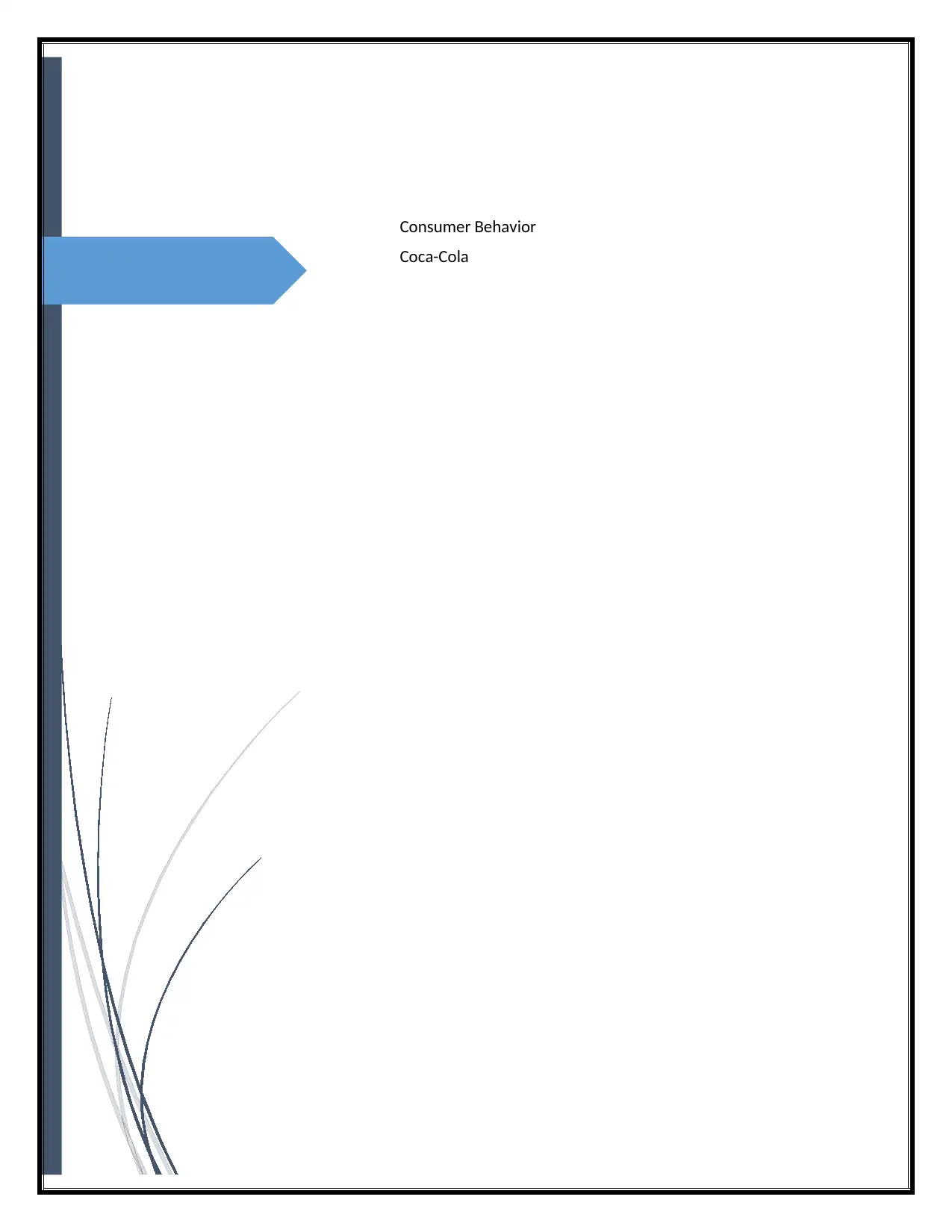
Consumer Behavior
Coca-Cola
Coca-Cola
Paraphrase This Document
Need a fresh take? Get an instant paraphrase of this document with our AI Paraphraser
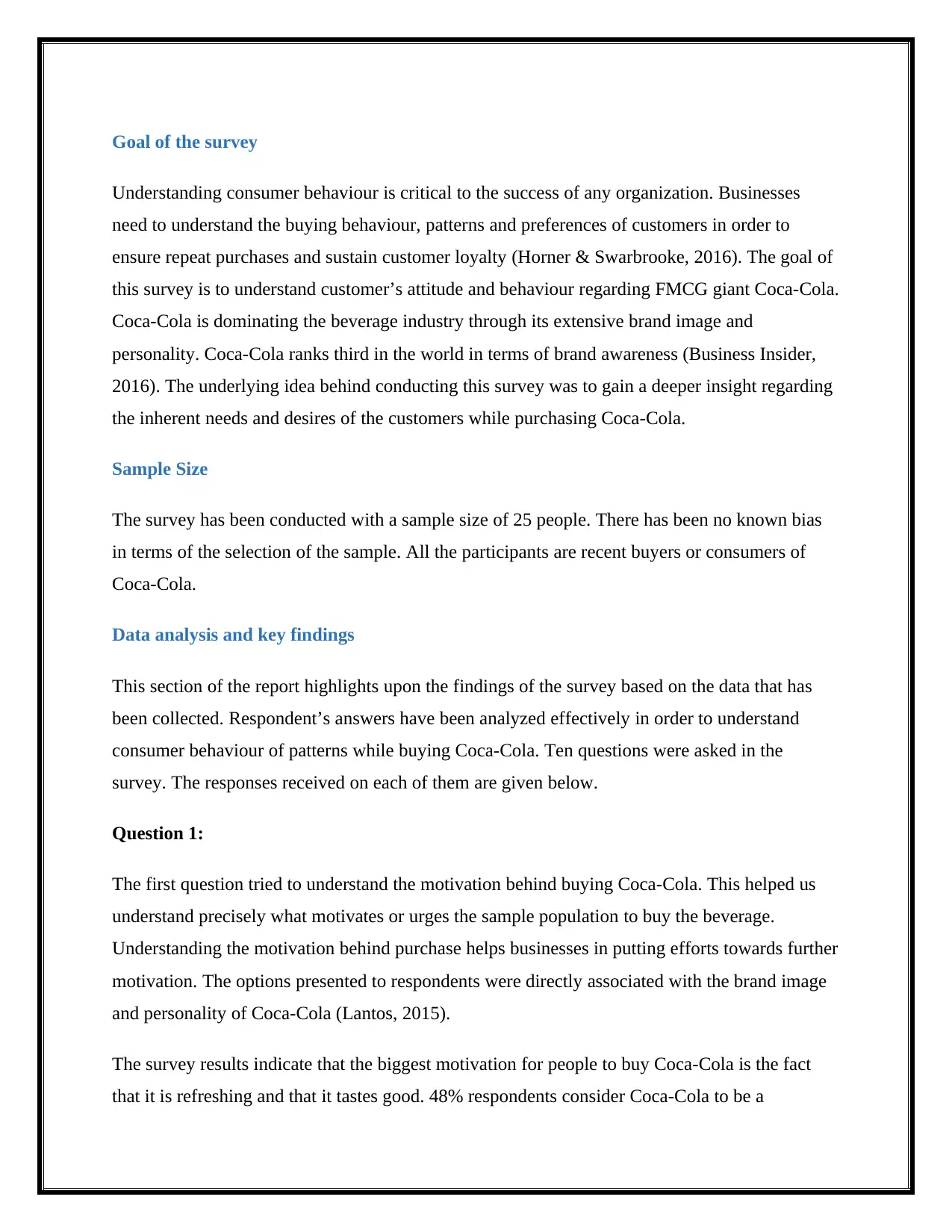
Goal of the survey
Understanding consumer behaviour is critical to the success of any organization. Businesses
need to understand the buying behaviour, patterns and preferences of customers in order to
ensure repeat purchases and sustain customer loyalty (Horner & Swarbrooke, 2016). The goal of
this survey is to understand customer’s attitude and behaviour regarding FMCG giant Coca-Cola.
Coca-Cola is dominating the beverage industry through its extensive brand image and
personality. Coca-Cola ranks third in the world in terms of brand awareness (Business Insider,
2016). The underlying idea behind conducting this survey was to gain a deeper insight regarding
the inherent needs and desires of the customers while purchasing Coca-Cola.
Sample Size
The survey has been conducted with a sample size of 25 people. There has been no known bias
in terms of the selection of the sample. All the participants are recent buyers or consumers of
Coca-Cola.
Data analysis and key findings
This section of the report highlights upon the findings of the survey based on the data that has
been collected. Respondent’s answers have been analyzed effectively in order to understand
consumer behaviour of patterns while buying Coca-Cola. Ten questions were asked in the
survey. The responses received on each of them are given below.
Question 1:
The first question tried to understand the motivation behind buying Coca-Cola. This helped us
understand precisely what motivates or urges the sample population to buy the beverage.
Understanding the motivation behind purchase helps businesses in putting efforts towards further
motivation. The options presented to respondents were directly associated with the brand image
and personality of Coca-Cola (Lantos, 2015).
The survey results indicate that the biggest motivation for people to buy Coca-Cola is the fact
that it is refreshing and that it tastes good. 48% respondents consider Coca-Cola to be a
Understanding consumer behaviour is critical to the success of any organization. Businesses
need to understand the buying behaviour, patterns and preferences of customers in order to
ensure repeat purchases and sustain customer loyalty (Horner & Swarbrooke, 2016). The goal of
this survey is to understand customer’s attitude and behaviour regarding FMCG giant Coca-Cola.
Coca-Cola is dominating the beverage industry through its extensive brand image and
personality. Coca-Cola ranks third in the world in terms of brand awareness (Business Insider,
2016). The underlying idea behind conducting this survey was to gain a deeper insight regarding
the inherent needs and desires of the customers while purchasing Coca-Cola.
Sample Size
The survey has been conducted with a sample size of 25 people. There has been no known bias
in terms of the selection of the sample. All the participants are recent buyers or consumers of
Coca-Cola.
Data analysis and key findings
This section of the report highlights upon the findings of the survey based on the data that has
been collected. Respondent’s answers have been analyzed effectively in order to understand
consumer behaviour of patterns while buying Coca-Cola. Ten questions were asked in the
survey. The responses received on each of them are given below.
Question 1:
The first question tried to understand the motivation behind buying Coca-Cola. This helped us
understand precisely what motivates or urges the sample population to buy the beverage.
Understanding the motivation behind purchase helps businesses in putting efforts towards further
motivation. The options presented to respondents were directly associated with the brand image
and personality of Coca-Cola (Lantos, 2015).
The survey results indicate that the biggest motivation for people to buy Coca-Cola is the fact
that it is refreshing and that it tastes good. 48% respondents consider Coca-Cola to be a

refreshing beverage. Hence the brand must consider this factor while devising its promotions
strategies.
Question 2:
The second question aims to understand the perception regarding the product before the
customer made the purchase. The before purchase perception comes from a variety of factors.
This may include the packaging of the product, efficient advertising by the organization, positive
word of mouth publicity or even the nature of product. It is important for organizations to
understand the perception about the product that consumers hold before buying the product
(Foxall, 2014). If that is low then businesses must put efforts in identifying the reason behind this
and towards improving the same.
Overall the perception of the sample population for Coca-Cola before buying the product was
positive as per 60% of the respondents. This reflects positively upon the advertising and
branding strategies adopted by Coca-Cola.
Question 3:
The third question understands the perception in the minds of consumers regarding the product
after making the purchase. This is important to understand if the perception post purchase has
improved, degraded or remained the same when compared to that before the purchase. This helps
in evaluating the post purchase behaviour of customers and their perception towards Coca-Coal.
If a business’s post purchase perception is worse than that before purchase then it signifies that
the business is able to create curiosity and excitement regarding the product but unable to meet
customer’s expectations (Maehle, Otnes & Supphellen, 2011).
For Coca-Cola, the post purchase perception remains positive with the same 60% of the
consumers depicting that the brand has been successful at building expectations as well as living
up to them.
Question 4:
The fourth question throws light on the family association of the product by understanding which
family members use Coca-Cola. This is important to understand how customers perceive Coca-
strategies.
Question 2:
The second question aims to understand the perception regarding the product before the
customer made the purchase. The before purchase perception comes from a variety of factors.
This may include the packaging of the product, efficient advertising by the organization, positive
word of mouth publicity or even the nature of product. It is important for organizations to
understand the perception about the product that consumers hold before buying the product
(Foxall, 2014). If that is low then businesses must put efforts in identifying the reason behind this
and towards improving the same.
Overall the perception of the sample population for Coca-Cola before buying the product was
positive as per 60% of the respondents. This reflects positively upon the advertising and
branding strategies adopted by Coca-Cola.
Question 3:
The third question understands the perception in the minds of consumers regarding the product
after making the purchase. This is important to understand if the perception post purchase has
improved, degraded or remained the same when compared to that before the purchase. This helps
in evaluating the post purchase behaviour of customers and their perception towards Coca-Coal.
If a business’s post purchase perception is worse than that before purchase then it signifies that
the business is able to create curiosity and excitement regarding the product but unable to meet
customer’s expectations (Maehle, Otnes & Supphellen, 2011).
For Coca-Cola, the post purchase perception remains positive with the same 60% of the
consumers depicting that the brand has been successful at building expectations as well as living
up to them.
Question 4:
The fourth question throws light on the family association of the product by understanding which
family members use Coca-Cola. This is important to understand how customers perceive Coca-
⊘ This is a preview!⊘
Do you want full access?
Subscribe today to unlock all pages.

Trusted by 1+ million students worldwide
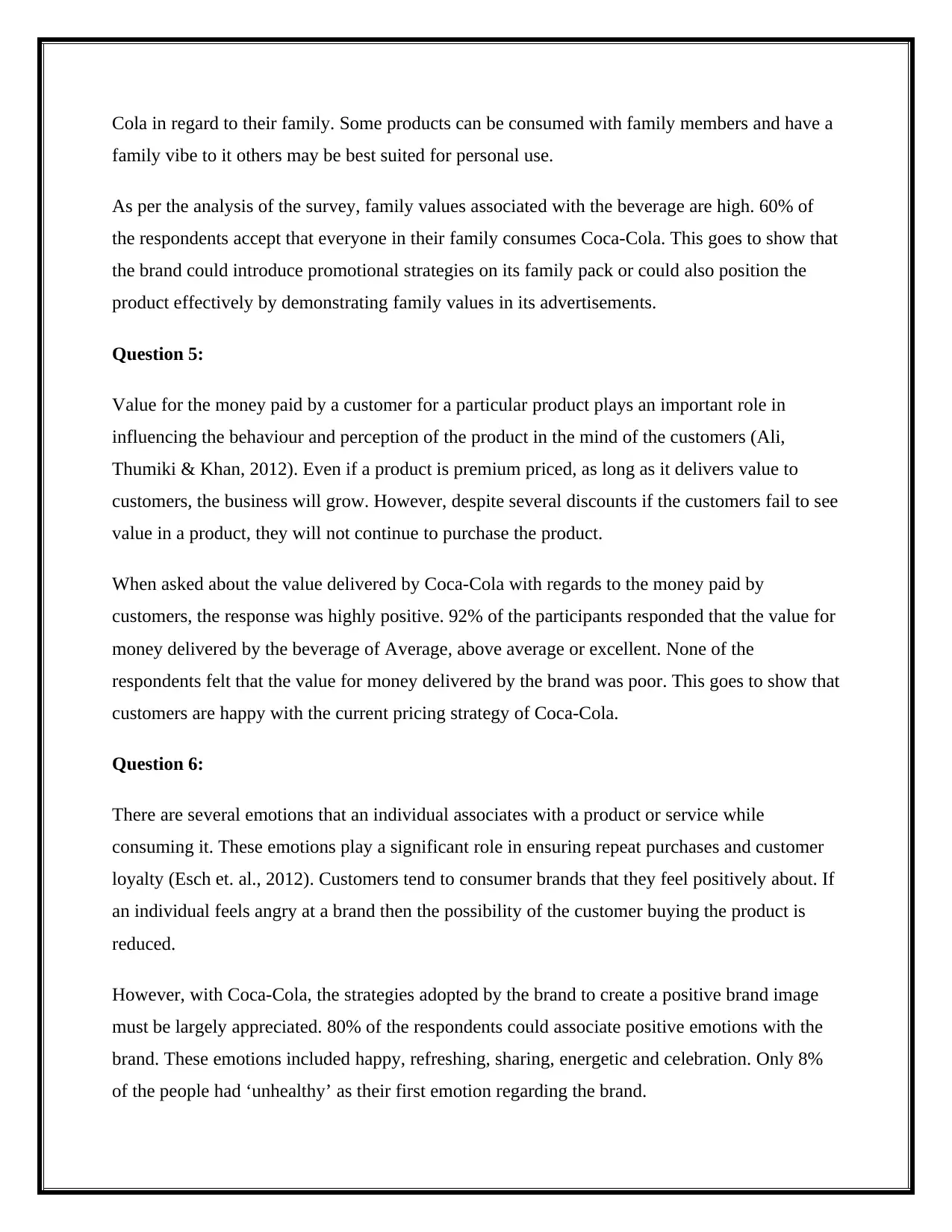
Cola in regard to their family. Some products can be consumed with family members and have a
family vibe to it others may be best suited for personal use.
As per the analysis of the survey, family values associated with the beverage are high. 60% of
the respondents accept that everyone in their family consumes Coca-Cola. This goes to show that
the brand could introduce promotional strategies on its family pack or could also position the
product effectively by demonstrating family values in its advertisements.
Question 5:
Value for the money paid by a customer for a particular product plays an important role in
influencing the behaviour and perception of the product in the mind of the customers (Ali,
Thumiki & Khan, 2012). Even if a product is premium priced, as long as it delivers value to
customers, the business will grow. However, despite several discounts if the customers fail to see
value in a product, they will not continue to purchase the product.
When asked about the value delivered by Coca-Cola with regards to the money paid by
customers, the response was highly positive. 92% of the participants responded that the value for
money delivered by the beverage of Average, above average or excellent. None of the
respondents felt that the value for money delivered by the brand was poor. This goes to show that
customers are happy with the current pricing strategy of Coca-Cola.
Question 6:
There are several emotions that an individual associates with a product or service while
consuming it. These emotions play a significant role in ensuring repeat purchases and customer
loyalty (Esch et. al., 2012). Customers tend to consumer brands that they feel positively about. If
an individual feels angry at a brand then the possibility of the customer buying the product is
reduced.
However, with Coca-Cola, the strategies adopted by the brand to create a positive brand image
must be largely appreciated. 80% of the respondents could associate positive emotions with the
brand. These emotions included happy, refreshing, sharing, energetic and celebration. Only 8%
of the people had ‘unhealthy’ as their first emotion regarding the brand.
family vibe to it others may be best suited for personal use.
As per the analysis of the survey, family values associated with the beverage are high. 60% of
the respondents accept that everyone in their family consumes Coca-Cola. This goes to show that
the brand could introduce promotional strategies on its family pack or could also position the
product effectively by demonstrating family values in its advertisements.
Question 5:
Value for the money paid by a customer for a particular product plays an important role in
influencing the behaviour and perception of the product in the mind of the customers (Ali,
Thumiki & Khan, 2012). Even if a product is premium priced, as long as it delivers value to
customers, the business will grow. However, despite several discounts if the customers fail to see
value in a product, they will not continue to purchase the product.
When asked about the value delivered by Coca-Cola with regards to the money paid by
customers, the response was highly positive. 92% of the participants responded that the value for
money delivered by the beverage of Average, above average or excellent. None of the
respondents felt that the value for money delivered by the brand was poor. This goes to show that
customers are happy with the current pricing strategy of Coca-Cola.
Question 6:
There are several emotions that an individual associates with a product or service while
consuming it. These emotions play a significant role in ensuring repeat purchases and customer
loyalty (Esch et. al., 2012). Customers tend to consumer brands that they feel positively about. If
an individual feels angry at a brand then the possibility of the customer buying the product is
reduced.
However, with Coca-Cola, the strategies adopted by the brand to create a positive brand image
must be largely appreciated. 80% of the respondents could associate positive emotions with the
brand. These emotions included happy, refreshing, sharing, energetic and celebration. Only 8%
of the people had ‘unhealthy’ as their first emotion regarding the brand.
Paraphrase This Document
Need a fresh take? Get an instant paraphrase of this document with our AI Paraphraser
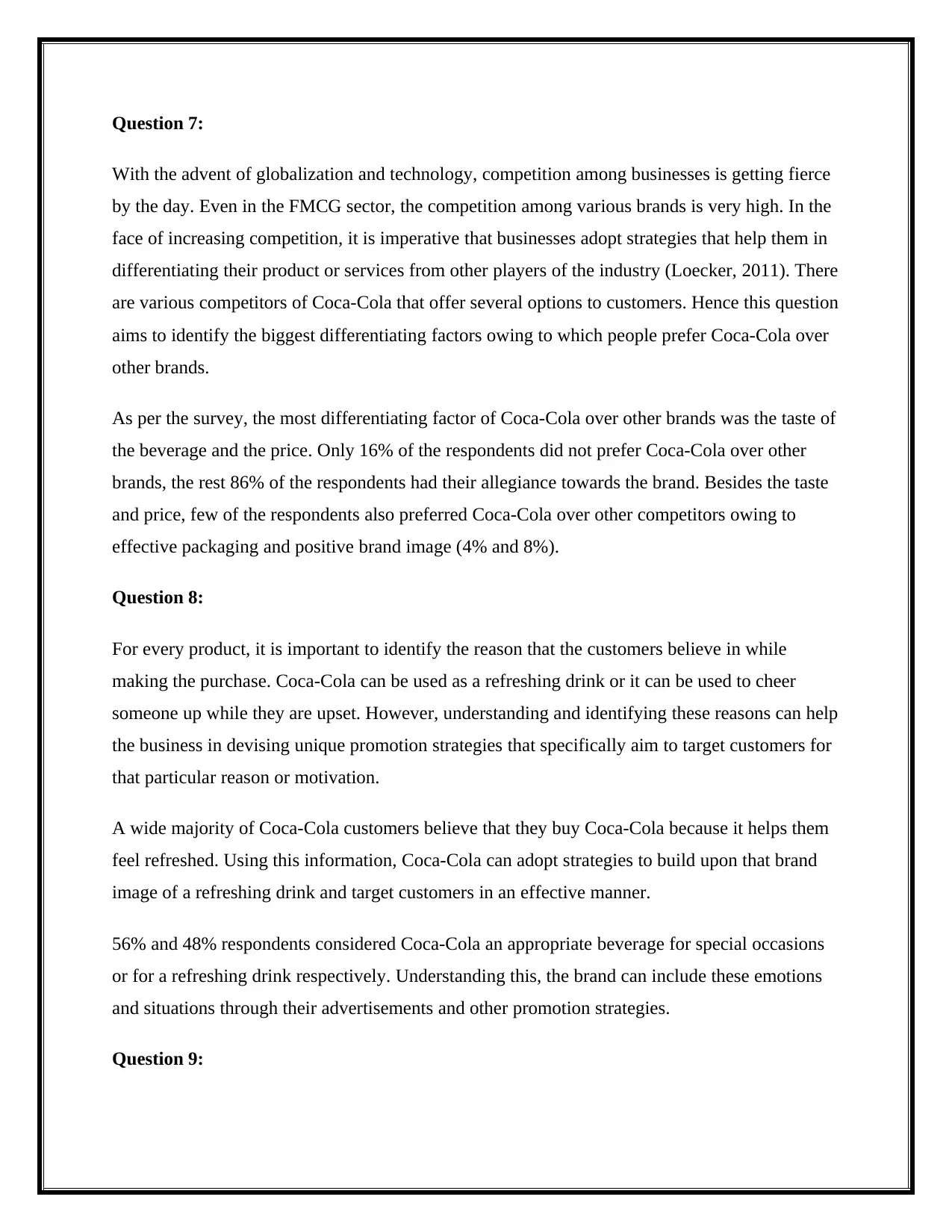
Question 7:
With the advent of globalization and technology, competition among businesses is getting fierce
by the day. Even in the FMCG sector, the competition among various brands is very high. In the
face of increasing competition, it is imperative that businesses adopt strategies that help them in
differentiating their product or services from other players of the industry (Loecker, 2011). There
are various competitors of Coca-Cola that offer several options to customers. Hence this question
aims to identify the biggest differentiating factors owing to which people prefer Coca-Cola over
other brands.
As per the survey, the most differentiating factor of Coca-Cola over other brands was the taste of
the beverage and the price. Only 16% of the respondents did not prefer Coca-Cola over other
brands, the rest 86% of the respondents had their allegiance towards the brand. Besides the taste
and price, few of the respondents also preferred Coca-Cola over other competitors owing to
effective packaging and positive brand image (4% and 8%).
Question 8:
For every product, it is important to identify the reason that the customers believe in while
making the purchase. Coca-Cola can be used as a refreshing drink or it can be used to cheer
someone up while they are upset. However, understanding and identifying these reasons can help
the business in devising unique promotion strategies that specifically aim to target customers for
that particular reason or motivation.
A wide majority of Coca-Cola customers believe that they buy Coca-Cola because it helps them
feel refreshed. Using this information, Coca-Cola can adopt strategies to build upon that brand
image of a refreshing drink and target customers in an effective manner.
56% and 48% respondents considered Coca-Cola an appropriate beverage for special occasions
or for a refreshing drink respectively. Understanding this, the brand can include these emotions
and situations through their advertisements and other promotion strategies.
Question 9:
With the advent of globalization and technology, competition among businesses is getting fierce
by the day. Even in the FMCG sector, the competition among various brands is very high. In the
face of increasing competition, it is imperative that businesses adopt strategies that help them in
differentiating their product or services from other players of the industry (Loecker, 2011). There
are various competitors of Coca-Cola that offer several options to customers. Hence this question
aims to identify the biggest differentiating factors owing to which people prefer Coca-Cola over
other brands.
As per the survey, the most differentiating factor of Coca-Cola over other brands was the taste of
the beverage and the price. Only 16% of the respondents did not prefer Coca-Cola over other
brands, the rest 86% of the respondents had their allegiance towards the brand. Besides the taste
and price, few of the respondents also preferred Coca-Cola over other competitors owing to
effective packaging and positive brand image (4% and 8%).
Question 8:
For every product, it is important to identify the reason that the customers believe in while
making the purchase. Coca-Cola can be used as a refreshing drink or it can be used to cheer
someone up while they are upset. However, understanding and identifying these reasons can help
the business in devising unique promotion strategies that specifically aim to target customers for
that particular reason or motivation.
A wide majority of Coca-Cola customers believe that they buy Coca-Cola because it helps them
feel refreshed. Using this information, Coca-Cola can adopt strategies to build upon that brand
image of a refreshing drink and target customers in an effective manner.
56% and 48% respondents considered Coca-Cola an appropriate beverage for special occasions
or for a refreshing drink respectively. Understanding this, the brand can include these emotions
and situations through their advertisements and other promotion strategies.
Question 9:
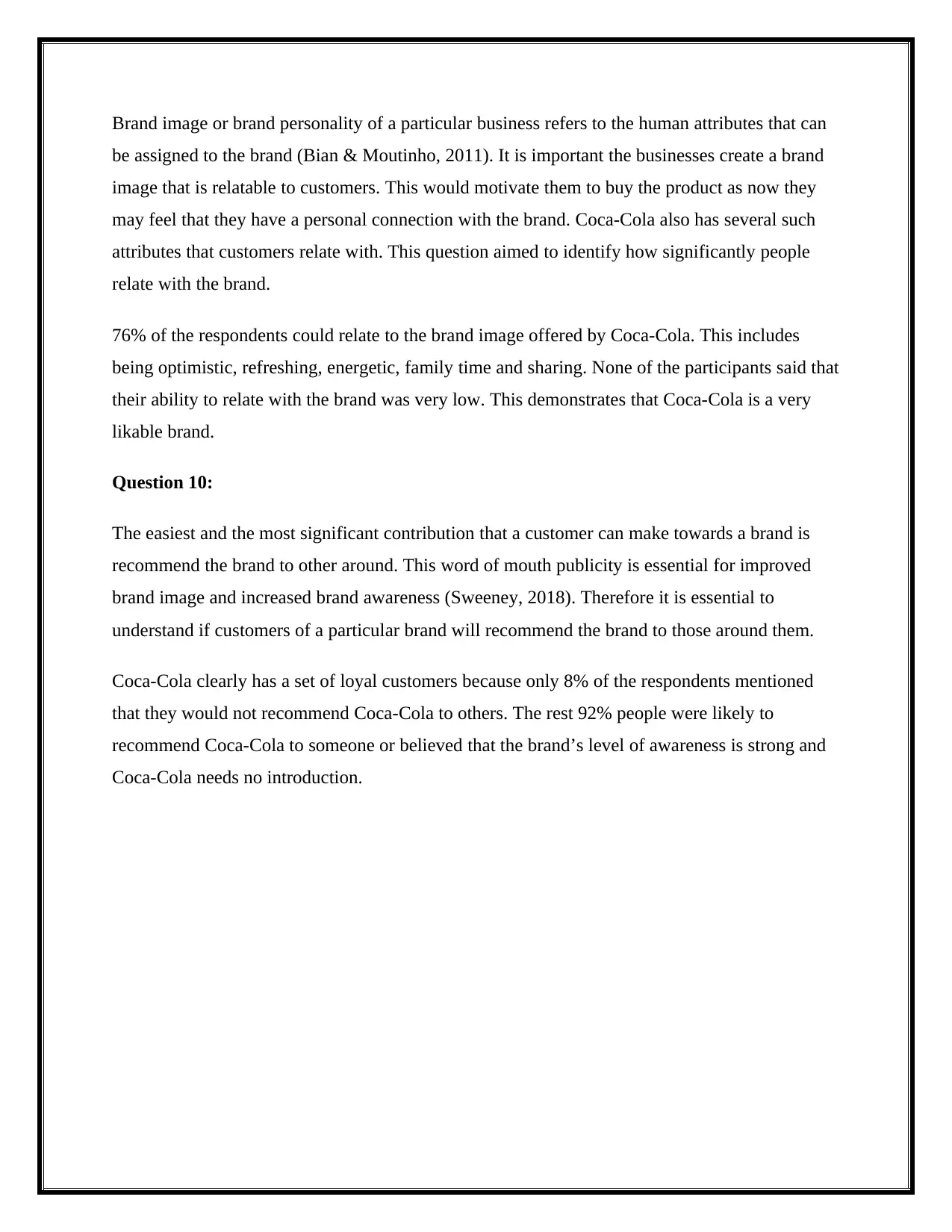
Brand image or brand personality of a particular business refers to the human attributes that can
be assigned to the brand (Bian & Moutinho, 2011). It is important the businesses create a brand
image that is relatable to customers. This would motivate them to buy the product as now they
may feel that they have a personal connection with the brand. Coca-Cola also has several such
attributes that customers relate with. This question aimed to identify how significantly people
relate with the brand.
76% of the respondents could relate to the brand image offered by Coca-Cola. This includes
being optimistic, refreshing, energetic, family time and sharing. None of the participants said that
their ability to relate with the brand was very low. This demonstrates that Coca-Cola is a very
likable brand.
Question 10:
The easiest and the most significant contribution that a customer can make towards a brand is
recommend the brand to other around. This word of mouth publicity is essential for improved
brand image and increased brand awareness (Sweeney, 2018). Therefore it is essential to
understand if customers of a particular brand will recommend the brand to those around them.
Coca-Cola clearly has a set of loyal customers because only 8% of the respondents mentioned
that they would not recommend Coca-Cola to others. The rest 92% people were likely to
recommend Coca-Cola to someone or believed that the brand’s level of awareness is strong and
Coca-Cola needs no introduction.
be assigned to the brand (Bian & Moutinho, 2011). It is important the businesses create a brand
image that is relatable to customers. This would motivate them to buy the product as now they
may feel that they have a personal connection with the brand. Coca-Cola also has several such
attributes that customers relate with. This question aimed to identify how significantly people
relate with the brand.
76% of the respondents could relate to the brand image offered by Coca-Cola. This includes
being optimistic, refreshing, energetic, family time and sharing. None of the participants said that
their ability to relate with the brand was very low. This demonstrates that Coca-Cola is a very
likable brand.
Question 10:
The easiest and the most significant contribution that a customer can make towards a brand is
recommend the brand to other around. This word of mouth publicity is essential for improved
brand image and increased brand awareness (Sweeney, 2018). Therefore it is essential to
understand if customers of a particular brand will recommend the brand to those around them.
Coca-Cola clearly has a set of loyal customers because only 8% of the respondents mentioned
that they would not recommend Coca-Cola to others. The rest 92% people were likely to
recommend Coca-Cola to someone or believed that the brand’s level of awareness is strong and
Coca-Cola needs no introduction.
⊘ This is a preview!⊘
Do you want full access?
Subscribe today to unlock all pages.

Trusted by 1+ million students worldwide
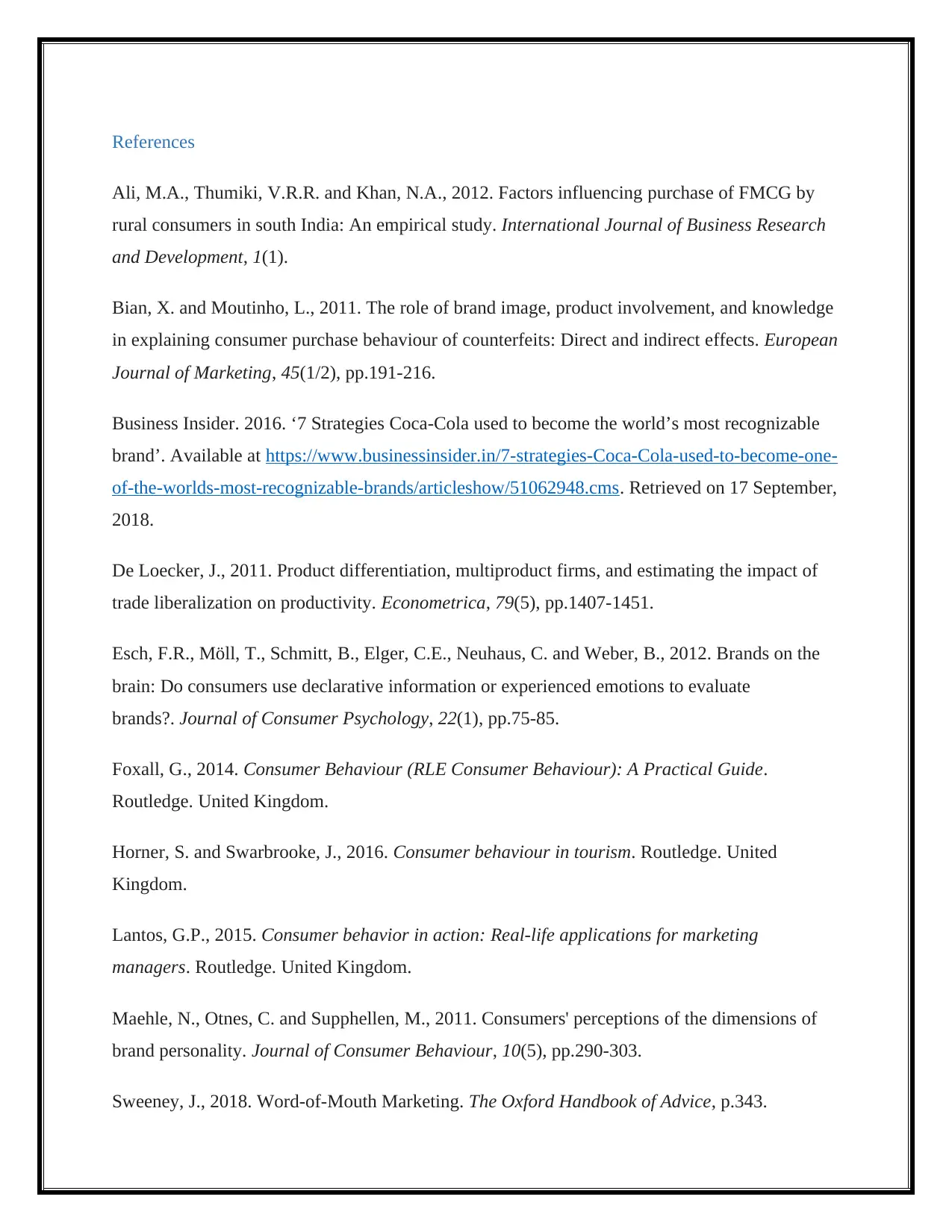
References
Ali, M.A., Thumiki, V.R.R. and Khan, N.A., 2012. Factors influencing purchase of FMCG by
rural consumers in south India: An empirical study. International Journal of Business Research
and Development, 1(1).
Bian, X. and Moutinho, L., 2011. The role of brand image, product involvement, and knowledge
in explaining consumer purchase behaviour of counterfeits: Direct and indirect effects. European
Journal of Marketing, 45(1/2), pp.191-216.
Business Insider. 2016. ‘7 Strategies Coca-Cola used to become the world’s most recognizable
brand’. Available at https://www.businessinsider.in/7-strategies-Coca-Cola-used-to-become-one-
of-the-worlds-most-recognizable-brands/articleshow/51062948.cms. Retrieved on 17 September,
2018.
De Loecker, J., 2011. Product differentiation, multiproduct firms, and estimating the impact of
trade liberalization on productivity. Econometrica, 79(5), pp.1407-1451.
Esch, F.R., Möll, T., Schmitt, B., Elger, C.E., Neuhaus, C. and Weber, B., 2012. Brands on the
brain: Do consumers use declarative information or experienced emotions to evaluate
brands?. Journal of Consumer Psychology, 22(1), pp.75-85.
Foxall, G., 2014. Consumer Behaviour (RLE Consumer Behaviour): A Practical Guide.
Routledge. United Kingdom.
Horner, S. and Swarbrooke, J., 2016. Consumer behaviour in tourism. Routledge. United
Kingdom.
Lantos, G.P., 2015. Consumer behavior in action: Real-life applications for marketing
managers. Routledge. United Kingdom.
Maehle, N., Otnes, C. and Supphellen, M., 2011. Consumers' perceptions of the dimensions of
brand personality. Journal of Consumer Behaviour, 10(5), pp.290-303.
Sweeney, J., 2018. Word-of-Mouth Marketing. The Oxford Handbook of Advice, p.343.
Ali, M.A., Thumiki, V.R.R. and Khan, N.A., 2012. Factors influencing purchase of FMCG by
rural consumers in south India: An empirical study. International Journal of Business Research
and Development, 1(1).
Bian, X. and Moutinho, L., 2011. The role of brand image, product involvement, and knowledge
in explaining consumer purchase behaviour of counterfeits: Direct and indirect effects. European
Journal of Marketing, 45(1/2), pp.191-216.
Business Insider. 2016. ‘7 Strategies Coca-Cola used to become the world’s most recognizable
brand’. Available at https://www.businessinsider.in/7-strategies-Coca-Cola-used-to-become-one-
of-the-worlds-most-recognizable-brands/articleshow/51062948.cms. Retrieved on 17 September,
2018.
De Loecker, J., 2011. Product differentiation, multiproduct firms, and estimating the impact of
trade liberalization on productivity. Econometrica, 79(5), pp.1407-1451.
Esch, F.R., Möll, T., Schmitt, B., Elger, C.E., Neuhaus, C. and Weber, B., 2012. Brands on the
brain: Do consumers use declarative information or experienced emotions to evaluate
brands?. Journal of Consumer Psychology, 22(1), pp.75-85.
Foxall, G., 2014. Consumer Behaviour (RLE Consumer Behaviour): A Practical Guide.
Routledge. United Kingdom.
Horner, S. and Swarbrooke, J., 2016. Consumer behaviour in tourism. Routledge. United
Kingdom.
Lantos, G.P., 2015. Consumer behavior in action: Real-life applications for marketing
managers. Routledge. United Kingdom.
Maehle, N., Otnes, C. and Supphellen, M., 2011. Consumers' perceptions of the dimensions of
brand personality. Journal of Consumer Behaviour, 10(5), pp.290-303.
Sweeney, J., 2018. Word-of-Mouth Marketing. The Oxford Handbook of Advice, p.343.
Paraphrase This Document
Need a fresh take? Get an instant paraphrase of this document with our AI Paraphraser

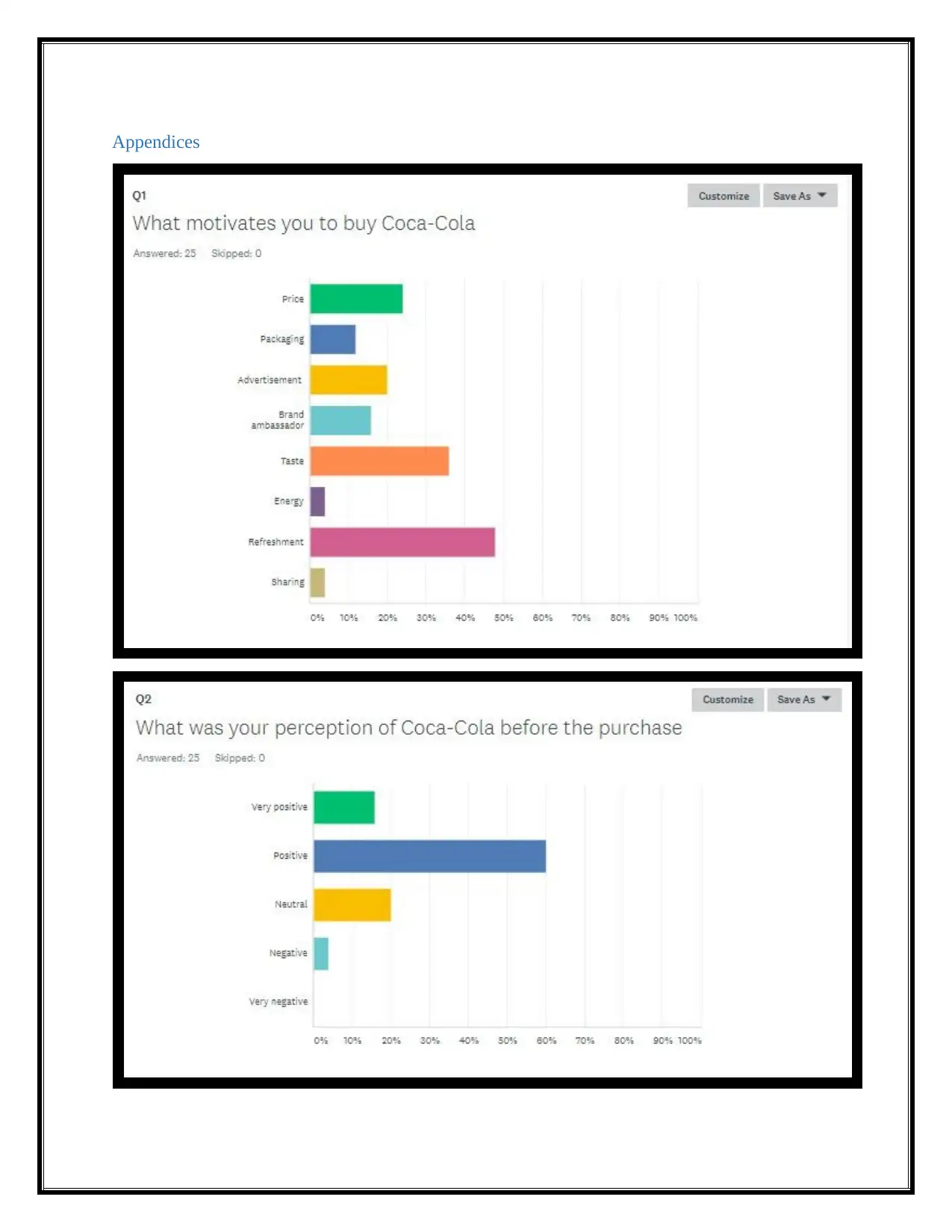
Appendices
⊘ This is a preview!⊘
Do you want full access?
Subscribe today to unlock all pages.

Trusted by 1+ million students worldwide
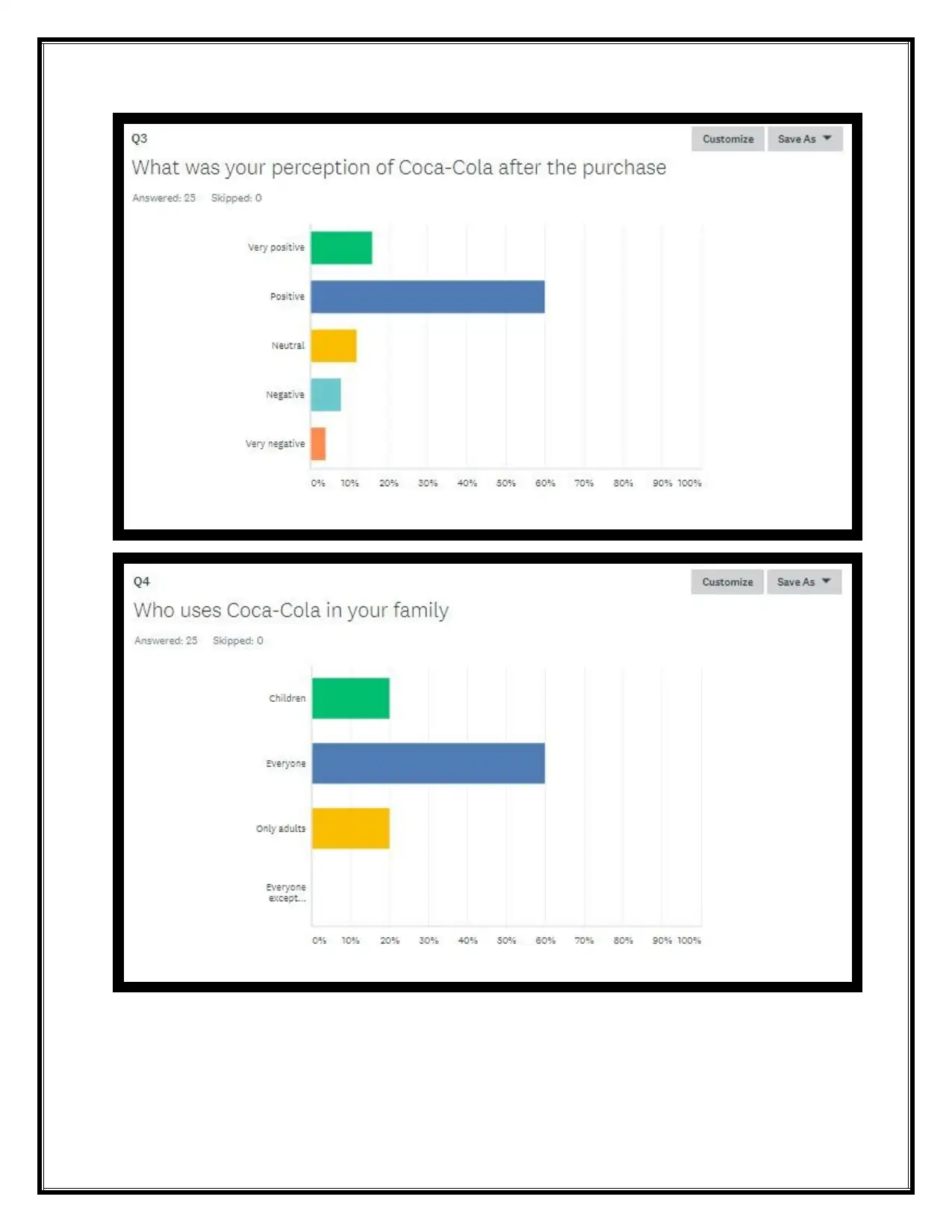
Paraphrase This Document
Need a fresh take? Get an instant paraphrase of this document with our AI Paraphraser
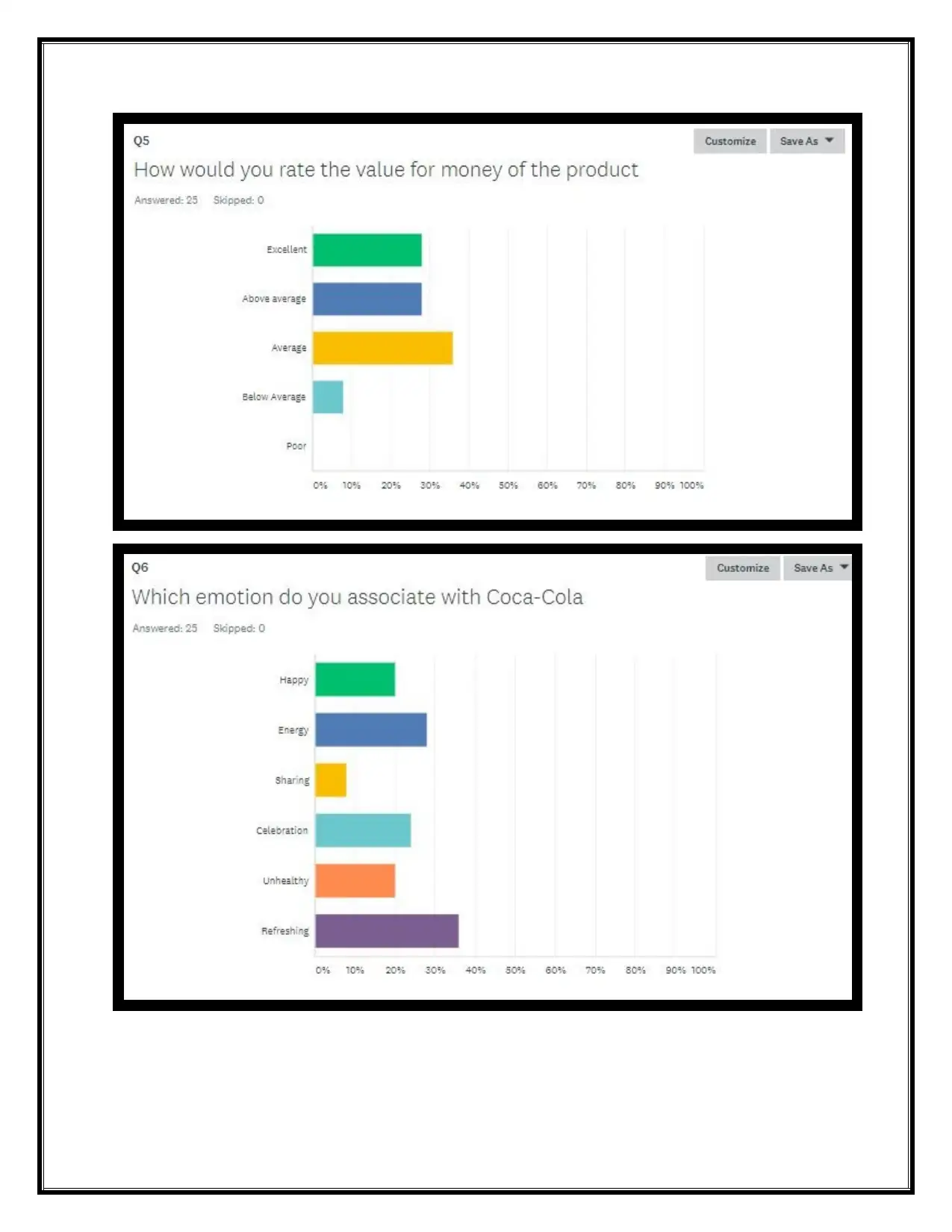

⊘ This is a preview!⊘
Do you want full access?
Subscribe today to unlock all pages.

Trusted by 1+ million students worldwide
1 out of 13
Related Documents
Your All-in-One AI-Powered Toolkit for Academic Success.
+13062052269
info@desklib.com
Available 24*7 on WhatsApp / Email
![[object Object]](/_next/static/media/star-bottom.7253800d.svg)
Unlock your academic potential
Copyright © 2020–2025 A2Z Services. All Rights Reserved. Developed and managed by ZUCOL.





